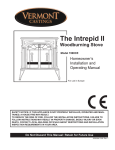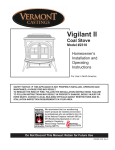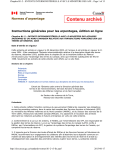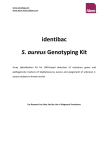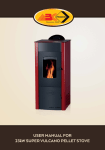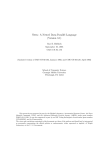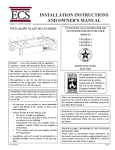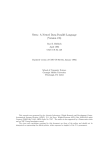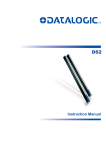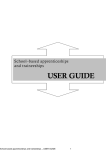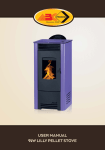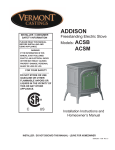Download 2000009 Rebuild Acclaim.indd
Transcript
O M N E C K Rebuild Instructions for the Resolute Acclaim H L H J B D K I F G A Please read through these instructions before beginning the procedure. Contents A. Bottom Plate, 1 B. Inner Side Plate, Left, 1 C. Inner Side Plate, Right, 1 D. Left End Plate, 1 E. Right End Plate, 1 F. Left Shoulder Plate, 1 G. Right Shoulder Plate, 1 H. Sealing Plate, 2 I. Left Arch Brick, 1 J. Right Arch Brick, 1 K. Side Brick, 2 L. Brick Retainer, Stainless Steel, 1 M. Rear Grate, 1 N. Front Grate, 1 O. Back Plate, 1 Tie Rod, 4 Flat Washer, 2 Nut, 1/4-20 Hex Hd Flex Lock, 4 CS 1/4-20 x 1 Blk Hex Hd, 2 Nut, Hex Hd 1/4-20 Pin CS, Hex Hd 1/4-20 x 5/8 ss Washer, Flat 1/4 #316 ss Tubes 11oz. V.C. Cement, 3 5’, 6” Gasket, 5/16” Med. Fiberglass 9 oz. Can High-Temperature Paint, 1 CAR166 Fig. 1 Carton contents. Suggested Tools CAR166 drop cloth, 8’ x 8’ (min.) Rebuild Resolute Acclaim safety goggles contents 11/04 putty knife needle nose pliers, 6” wire brush 1¹⁄₂” x 6”, 13 overall shop vac w/attachments 7/16”, 1/2” and 9/16” combination wrenches (box and open end) 3/8” drive ratchet handle 3/8” drive extension, 6” wrench, socket, 7/16” deepwell, 3/8” drive wrench, socket, 9/16” deepwell, 3/8” drive common flat blade screwdriver 6” long Phillips screwdriver #3 tip, 8” long Phillips screwdriver #2 tip, 6” long hex key (allen) wrench 5/32” and 1/8” drop light a.c. 40-60 watt, 15’-25’ cord pair locking pliers 6” - 10” ball peen hammer, 12 oz. or 16 oz. hammer, brass face 12 oz. or 16 oz. rubber mallet 4 lb. dead blow cold chisel, 3/8” punch/drive pin, 1/8”, 3/8” and 1/4” caulking gun rolling head pry bar, 1/2” x 15” pinch bar, 1/2” x 15” sponge or water absorbent cloth pair cutting shears, 6” - 8” Repair/rebuild stand measuring tape clean rags 2000009 8/08 Rev. 3 Introduction These instructions cover the rebuilding of the Resolute Acclaim Stove. Since the design has been modified over the years, your rebuilt stove may differ from the original. Current and rebuilt models have stationary grates instead of sliding grates. Also, they have an air control which includes a “start-up position” which allows extra air to enter the firebox when starting a fire. After the fire is established, the normal range for the air valve control is from full left (for long-lasting, slow burning fires) to the centerpoint for faster, hotter fires. To use the revised valve control, you swing the control handle to the right until you meet resistance, then press it down and further to the right to allow the greatest amount of air into the firebox. Note, however, that continued burning at the highest firing rates can significantly shorten the life of the inner castings. Disassembly 1. Lift out the grate. Remove the ash pan and dump the ashes in a safe container outdoors. Wash the ash pan and dry it. The ash pan will make a good container for screws, bolts, nuts, washers and small hardware items during the disassembly of the stove. 2. Remove the loading door. Open the door and pull down on the spring loaded upper hinge pin. When the upper hinge pin clears its recess, tilt the door slightly and lift it off the lower hinge pin. Use care to avoid chipping the enamel surface. Remove the andirons. 3. Clean out the firebox thoroughly. Vacuum the entire firebox and ash drop area with the shop vacuum. 4. Lift out the top and bottom grate sections. If the stove has moveable shaker grates, discard these. Retain stationary grates. 5. Using a 7/16” wrench, remove the flue collar and flue collar extension, (four 1/4-20 x 5/8” hex head cap screws, and four 1/4” standard flat washers from within the stove). Keep the fasteners for reassembly. 6. Tap the wedges holding the lower fireback in place upward and remove them. Lift the lower fireback assembly slightly and shift it sideways so it clears the tab on one of the core sides and remove it from the stove. Discard the lower fireback and wedges. 7. Remove the damper handle stub. Loosen the socket set screw in the stub with a 5/32” hex key wrench (Allen) and pull the stub off the damper shaft. 8. Remove the right stove end. Reach inside the firebox and remove the hex head cap screw, 1/4-20 x 3/4” and one standard flat washer, 1/4”. A 7/16” wrench/socket is required. Discard right end. 2 NOTE: Later model stoves use a 3/8-16 x 1” hex head cap screw and a standard 3/8” flat washer. If this is the case, a 9/16” wrench/socket is required. 9. Remove the left stove end using the same tools and procedure as for the right end. Discard the left end. 10. Reach underneath the four corners of the stove bottom and remove the four 1/4-20 hex nuts from the ends of the four tie rods. (A 7/16” socket is required.) 11. Tap the perimeter of the top plate upward with a rubber mallet until the top plate can be lifted off the stove. 12. Remove the tie rods from the top plate. Discard the tie rods and nuts. 13. Remove the washer and spacer from the damper rod and retain for reassembly. Remove the damper rod. 14. Remove the upper fireback assembly, (two 1/4-20 x 3/4” hex head cap screws and two flat washers.) A 7/16” socket is required. 15. Carefully lift out the secondary combustion package and set it aside where it will not become damaged. 16. Remove the ash pit plate, (two 1/4-20 x 1” Phillips flat head machine screws). It may be necessary to insert the tip of the #2 Phillips screwdriver into the screw heads and give the screwdriver handle several sharp raps with a ball peen hammer. Pry the plate up with the common screwdriver once the screws are removed. 17. Loosen the right and left shoulder plates. Tap a 3/8” or 1/2” cold chisel into the front joint where the shoulder plate joins the stove front to break the cement seal. Tap a 3/8” or 1/2” cold chisel into the joints between the rear lower edges of the shoulder plates and the stove bottom and break the cement seal. Discard the shoulder plates. 18. This step is most easily accomplished by two people to prevent the front and back from falling when the core sides are removed. Remove the right and left core sides. Tap each core side outward with the dead blow mallet breaking the cement seal between the core sides and the front and back plates. Rock the core sides back and forth to beak the cement seal between the core sides and the stove bottom. If the shoulder plates are still attached to the core sides, remove the grate rod from the left shoulder plate and gently tap them loose with the dead blow mallet. Discard the core sides. 19. Remove the grate actuator rod from the stove bottom. Unscrew the grate actuator loop on the outside end of the rod and remove the grate actuator rod from inside the stove bottom. Discard the rod. 2000009 20. Remove the front and back plates from the stove bottom. Gently rock back and forth until the cement seal is broken and lift them off the bottom plate. Discard the back plate. Remove all heat shields and fasteners. 21. Using the 7/16” wrench/socket, remove the secondary combustion package support plate from inside the bottom of the back plate, (two 1/4-20 x 1/2” hex head cap screws). Tap the support plate loose from the back plate with the dead blow mallet. 22. At this time, inspect the gasket material within and around the upper fireback/damper assembly. If deterioration is evident, install new gaskets following the procedures outlined in the Resolute Acclaim Service Manual. 23. Disassemble the primary air valve. Loosen and remove the 1/4-20 hex lock nut, from inside the stove bottom. Turn the stove bottom over and remove the hex head cap screw which secures the air valve, spring, washer and shaft to the stove bottom (two 7/16” wrenches required). Keep all hardware for reassembly. 24. Use a 7/16” wrench/socket to remove the ashlip, (two hex head cap screws, 1/4-20 x 5/8” and two 1/4” flat washer). Retain the hardware. 25. Use a 9/16” socket to remove the stove legs, (four 3/8-16 x 1” hex head cap screws, three 3/8” flat washers and one damper handle holder). 26. Examine the secondary combustion package assembly. Check the refractory chamber and ramp for breaks, chips, separations and/or general deterioration. If the refractory chamber and ramp are in good condition, clean it carefully with negative pressure from your vacuum cleaner. Do not blow the passages with forced air. If the refractory chamber is in poor condition, seal it in a plastic bag and dispose of. Replace with a new one. 27. Examine all castings for cracks, chips, distortion, etc. Remove all old furnace cements from channels and mating surfaces using the appropriate size punch/drive pin in the channels and cold chisels on the flanges and flat mating surfaces. Clean all channels and mating surfaces with a wire brush (hand or power). 28. Examine all mechanical linkage parts for distortion, worn or egg shaped drillings, unusual wear, burrs, etc. Repair or replace as necessary. Replace any bent tabs or clips. 2000009 Gasket Locations Back (inside) ST832 Fig. 2 Inside vertical edges of back plate to vertical edges of the upper and lower firebacks seal. Two pieces 20” each, ST832 fiberglass, 5/16” diameter. inside back 11/04 Back (outside) ST833 Fig. 3 Exterior, channel around flue collar opening, 27”, fiberglass, 5/16” diameter. ST833 outside back 11/04 3 Assembly 1. Invert the new bottom and place it on your rebuild stand. Install six hex head cap screws 10-24 x 1/2” if heat shields will not be used. (Fig. 1) 2. Install the four legs onto the stove bottom with the four hex head cap screws 3/8”-16 x 1” and three 3/8” flat washers plus one each holder, damper handle insert on the right rear leg. (Fig. 1) ST835 Fig. 2 Primary air valve assembly. ST834 Fig. 1 Bottom assembly. 3. Lift the front of the inverted bottom and slide the old ashlip into position. Align the holes in the stove bottom with the two drilled andST834 tapped bosses on the ashlip and attach loosely with two 1/4-20 x 5/8” hex bottom head cap screws, and two 1/4” flat washers. Do not 11/04 tighten at this time. 4. Assemble the primary air valve, place the “U” portion of the air valve shaft between and around the upsets on the air valve casting with the upset on the valve shaft towards the underside of the ashlip. Place the compression spring on the 1/4-20 x 1¹⁄₄” hex head cap screw, next place the 1/4” x 1” outside diameter washer on the cap screw. Insert the cap screw with spring and washer through the air valve shaft and air valve, and thread it into the stove bottom until the spring is almost fully compressed. Thread a 1/4-20 hex nut onto the air valve cap screw from inside the stove bottom and tighten the screw against the stove bottom. The air valve is properly adjusted when you feel resistance to movement of the air valve shaft but the shaft moves from stop to stop easily. (Fig. 2) 4 5. Turn the stove bottom right side up on your rebuild stand. 6. Place the stove back on its back and install the damper rod into the holes on either side. Insert the longer stepped end first into the right side, shorter end to the left. (Fig. 3) ST835 7. Cement the bottom of the new stove back as indicated in Figure 4.primary Place the air old package support plate into position11/04 in the stove back. Align the holes in the package support plate with the drilled and tapped holes in the bottom of the stove back. Secure with two 1/4-20 x 1/2” hex head cap screws. Press the two gasket tails at the bottom of the stove into place over the lip of support plate. (Fig. 5) ST836 Fig. 3 Install damper rod. ST836 damper rod 11/04 2000009 ST839 Fig. 6 Bottom plate cement locations. Apply Cement Here ST837 Fig. 4 Cement bottom plate. ST839 bottom plate cement 11/04 ST837 cement bottom 11/04 ST840 Fig. 7 Top plate cement locations. ST838 Fig. 5 Install package support. 8. Carefully place the secondary combustion package into the recess in the back. Be sure to position the package with the ST838 ramp opening facing down and toward the front. package support 9. Place the old upper fireback/damper assembly into 11/04 position on the front gasketed flanges of the stove back. Align the semicircle cutouts on the sides of the upper fireback assembly with the drilled and tapped holes in the front flanges of the stove back. Secure loosely with 2 each 1/4” flat washers. Do not tighten the cap screws at this time. 10. Install the two sealing plates, rib side inward, onto the back over the secondary combustion package using a 1/4-20 x 5/8” stainless steel hex screw and 1/4” flat stainless steel washer for each. 11. Cement the channels in the stove bottom as indicated in Figure 6. 12. Cement the channels in the underside of the top plate as indicated in Figure 7. 2000009 13. Place the assembled stove back into its cemented channel in the stove bottom. 14. Insert the four tieST840 rods through the holes in the bottop plate cement tom plate. The longer threaded end goes through the bottom. 11/04 15. Place the assembled stove front into its cemented channel in the stove bottom and hold it and the back vertical with a wood bridge. (Fig. 8) 27" 10" 19" 6" ST841 Fig. 8 Wood bridge dimensions. 16. Cement the channels in the inner side plates as shown in Figure 9. Place the bottom of each inner ST841 in the stove bottom at side into its cement channel wood bridge a 45° angle and swing the top against the edges 11/04 of the stove back and front insuring the cement channels in the inner sides encompass the ribs of the stove back and front. Tie a rope or strap around the inner sides, back and front plates to hold the assembly together. Remove the wood bridge. 5 22. Install the left stove end and secure it with one 1/420 x 1” hex head cap screw, flat washer and 1/4-20 nut at the clevis in the bottom plate. Tighten the ashlip bolts. 23. Cement the stove bottom, air manifold and right inner side at the locations indicated in Figure 10. Install the right shoulder plate into position. 24. Cement the stove bottom, air manifold and left inner side at the locations indicated in Figure 11. Install the left shoulder plate into position. ST842 Fig. 9 Inner side plate cement locations. Refer also to Figures 10 and 11. 17. Place the cemented stove top into position insuring ST842 the top edges of the front, back and inner sides are side plate properly seated into their cement channels in the cement underside of the stove top. Rap the corners of the top plate with a rubber 11/04mallet to ensure a proper seat. 18. Thread each tie rod up into the tapped hole in the underside of the top plate. Continue to thread the tie rods into the stove top as far as you can with your fingers. As you tighten the tie rods, work in alternate sequence to opposite corners. Thread four each 1/4-20 hex nuts on the long threaded lower ends of the four tie rods and tighten securely in an alternating sequence. Remove the strap from the assembly. 19. Push the damper rod all the way over to the left. Place the 3/8” x 1” spacer on the right end of the damper rod. Place the 3/8” flat washer onto the damper rod and push it against the spacer. 20. Install the right stove end. Swing the bottom of the stove end out from the side of the stove until you are able to insert the end of the damper rod through its drilling in the stove end. Swing the stove end down into its installed position and secure it with one 1/4-20 x 1” black hex head bolt, flat washer and 1/4-20 nut at the clevis in the bottom plate. 21. Working from the back side of the stove, push or gently tap the left end of the damper rod as far to the right side of the stove as it will go. Install the damper handle stub onto the damper rod as far as it will go and secure it by tightening the socket set screw tightly against the flat of the damper rod with the 5/32” Allen wrench so when the damper is closed a tight, firm lock position is achieved. Tighten the lock nut on the ramp adjusting set screw. 6 ST844 Fig. 10 Cement locations: right shoulder, inner side. ST843 Fig. 11ST844 Cement locations: left shoulder, inner side. 25. Cement the stovecement bottom and the left and right shoulder shoulder plates at the locations indicated in Figure 11/04 12. Install the ash pit plate. The two cutouts along the long edge go toward the back of the stove. Secure with two Phillips flat head machine screws, 1/4-20 x 1”. 26. Install the flue collar and secure with two 1/4-20 x 5/8” hex head cap screws and two 1/4” flat washers. Install the flue collar extension and secure with two 1/4-20 x 5/8” hex head cap screws and two 1/4” flat washers. 27. Install the rear and (large) front grates into position between the shoulders inside the stove. 28. Install the left and right arch bricks. First, set the bottoms of both arches into position against the fireback, (ribbed face forward). Then, join the two ST843 left shoulder cem 11/04 2000009 Break-In Procedure The new castings just installed in the unit require the same seasoning process recommended for a new stove. This entails burning 3-4 small fires and allowing the stove to cool down between each. Failure to breakin the castings can cause damage to occur. ST845 Fig. 12 Cement ash pit plate. 29. 30. 31. 32. 33. by tilting both forward enough together to insert the stainless steel retainer over the upper ends and ST841 across the middle joint. Tilt the assembly back to cement ash pit rest against the fireback. Set each side brick11/04 into place. First, insert the rear edge into a back corner, then swing the forward edge to the side and up over the shoulder rib. Install the drop-in andirons and the ash pan. Drop the andirons into their respective slots in the front edge of the stationary grate with the cast design on the andirons facing outward. Install the loading door. Holding the door in the vertical position and 75-90 degree in relation to the stove front, place the lower hinge drilling onto the adjustable bottom hinge pin. Pull down on the spring loaded upper hinge pin and maneuver the top of the door so the spring loaded hinge pin enters the upper hinge drilling. Close the door and listen for any metal to metal contact. Check the upper and lower horizontal alignment of the door in relation to the stove top and the ash lip. If you hear metal to metal contact when closing the door or there is a wide gap at the top, open the door, pull down on the upper hinge pin, lift the door off the lower hinge pin with the 1/2” wrench and turn the hinge pin 360° counterclockwise. This will raise the door approximately 1/16”. Tighten the hinge pin and reinstall the door. Close the door and again listen for metal to metal contact and check alignment. Continue the adjustment process until a good seal is obtained, alignment is good and no metal to metal contact is heard. Paint the stove. Use Castings High Temperature Stove Paint (black) part number 000-0086, (9 oz.). Follow the directions printed on the can. Install the griddle in its proper position in the stove top. 2000009 7 MHSC 149 Cleveland Drive • Paris, Kentucky 40361 www.mhsc.com








